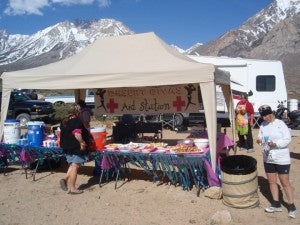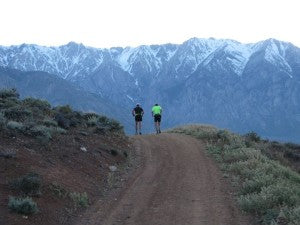The High Sierra Ultramarathons are special to Bishop, our small ultramarathon community, and to Northern Inyo hospital, that typically receives $10,000 annually from the fundraiser. Bishop benefits from hotel rooms filling up, restaurants being full, and shopping taking place from all the out-of-town racers. The ultramarathon community gathers together by marking the course and stuffing race bags while drinking beer before race day. Many racers were introduced to the sport of ultrarunning through this race, and more than a few folks have retired here after running this course. It is the core of the ultramarathon community in Bishop. Unfortunately, 2013 might be the last year for the Bishop High Sierra Ultramarathons. Someone recently told me that Marie Boyd, the race director, said she feels like she is planning a wedding every year, and 2013 is her last. If you want to run this race, this is the year to do it; otherwise, it is entirely possible the opportunity will not come back.

I asked a few seasoned BHS runners for advice for newbie runners and/or seasoned ultra-runners who are interested in giving this race a go. Their advice ranges from racing tactics to course specific tips all which are beneficial.
The four races 20 mile, 50k, 50 mile, and 100k are all different, but share the same long uphill at the beginning and downhill at the end. The hills were a common thread in all the training advice.
- Lots of uphill hiking practice.
- Practice downhill running or hiking on some rocky or sandy roads.
- Take it easy on the way up so that you'll be able to make the most of the long downhill to the finish.
- Mimic the race course conditions as much as possible, for HS Ultras this means very long climbs and very long descents, sometimes soft sand dirt road surfaces, elevation (ranges from 4400-8000' or 9400')
- Do your long runs somewhere where at the very least you can experience going uphill for an hour or 2 straight and downhill for the same, the downhill training is especially important because the eccentric muscle contractions of prolonged downhill running will really trash your quads if they aren't prepared for it.
Exposure to sun, heat, and altitude are environmental factors seasoned runners mentioned as something to definitely prepare for.
- Prepare for exposure(no shade) and potentially hot and dry weather conditions.
- If it is really warm on race day, tie something loosely around your neck that you can get wet and put ice in. That helps to keep your core temperature down.
-
It has snowed on race day but heat is much more common so acclimating to it will really be beneficial...practice drinking 20-30oz of fluid(some H20 and electrolyte/carbo drink)/hr in warm conditions so your body is used to processing that much fluid on race day
- The two biggest factors that runners fail to adequately acknowledge resulting in a sub-par performance are exposure and altitude. Literally there are only a handful of trees along the course so prepare to be in the sun all day long, especially if you live in the shade.
- The course isn’t a “mountain course” but the elevation is higher than what most people regularly train at so altitude can be a debilitating factor that most people underestimate.
- It's usually hot, dry and windy for at least part of the course, so stay on top of your hydration and electrolytes, or it'll be a suffer-fest getting to the finish line. Carry at least one water bottle.
- Shady hat and sunblock - it is a very exposed environment, most likely sunny and warm for most of the day, very little shade on the course.
- It really helps to be acclimated to the altitude and the heat, so train as much as you can at higher altitudes and in the heat.

The BHS Ultramarathons have well-stocked aid stations, however, experts recommend carrying at least a water bottle, and having their running gear dialed. Here are some tips on how to plan for the race.
-
Bring either a waist or shoulder pack; you will need to have something to carry fluids. There are a lot of aid stations, fairly closely spaced (relatively speaking for an ultra), so you don't need a huge reservoir.
- Apply an anti-chafing substance(such as BodyGlide) ANYWHERE you might get rubbed raw by skin-on-skin, pack straps, etc.
- Study the course map and familiarize yourself with aid stations and drop bag locations. These are strategically placed along the course and having something specific at a drop bag location a runner may need during the day can make the difference between a DNF and a successful personal best.
- Use shoes on race day that are broken in but still have relatively few miles on them so they are as close to new as possible without being an "unknown" factor for your feet and legs.
- Buy the best shoes you can afford.


